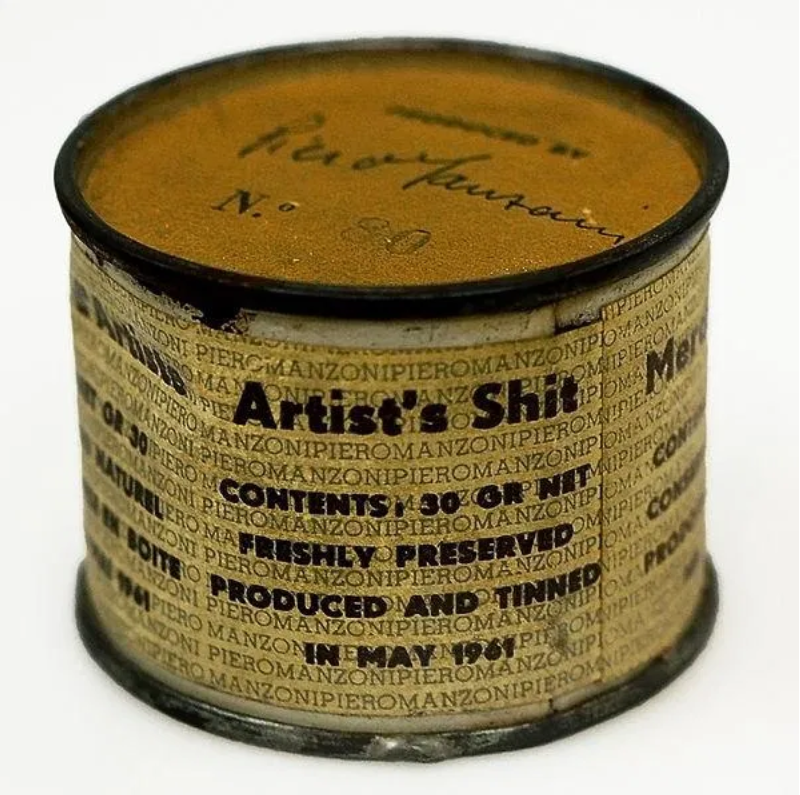
“Artist’s Shit” (Italian: Merda d’artista) is a work of conceptual art by the Italian artist Pier Manzoni from 1961.
It is a series of metal cans with contents consistent with the title. The artist determined the price of the can as the equivalent of the grammage in gold.
Your work is crap – it is said that this critical statement by the father of the Italian artist Manzoni gave him the idea for a new work of art. In response to this insult, Manzoni packed his droppings into 90 numbered cans in May 1961. Each contained 30 grams of excrement and was labeled with the name of the artist’s Shit (in Italian, English, French and German), with the entire description of the can read:
Artist shit
Net content 30 g
Preserved fresh
Manufactured and preserved
in May 1961
Today, Manzoni cans are priced at $ 100,000.
Actually, a classification question opens up: is Manzoni’s Shit a sculpture, installation, or performance? It is supposed to be an installation, though small in size, but maybe a sculpture, because it is a closed object filled with content, or maybe a performance, because creating this object required a “performance” on the part of the artist … How do you think? Write in the comment.
On the Tate Modern website, which is the proud owner of the 004 can, Sophie Howarth writes:
In December 1961, Manzoni wrote in a letter to artist Ben Vautier: “I wish all artists would sell their fingerprints or hold contests to see who can draw the longest line or sell their shit in cans. The fingerprint is the only sign of personality that is acceptable: if collectors want something intimate, truly personal, from an artist, there is, for example, an artist’s shit like this, something that is really his. ” It is not known exactly how many cans of Artist’s Shit were sold during Manzoni’s lifetime, but the receipt of August 23, 1962 confirms that Manzoni sold one Alberto L Albercia for 30 grams of 18 ct gold. Manzoni’s decision to price his excrement on a par with the price of gold clearly alluded to the tradition of understanding the artist as an alchemist. As Jon Thompson wrote: Critical and metaphorical reification of the artist’s body, its processes and products by Manzoni showed the way to understand the artist’s personality and the creation of the artist’s body as a consumer object. Merda d’artista, artist’s shit, dried naturally and preserved “without added preservatives”, was a perfect metaphor for the carnal and disembodied nature of artistic work: a work of art as a wholesome raw material and its violent labeling as a commodity. Manzoni understood the creative act as part of the consumption cycle: as continuous processing, packaging, marketing, consumption, reprocessing, packaging, and so on. Artist’s Shit was created at a time when Manzoni was creating various works involving the fetishization and commodification of the substances of his own body. These included fingerprinting the eggs before eating them and selling balloons filled with his own breath. Of these works, the Artist’s Shit cans have become the most famous, in part because of the continuing uncertainty as to whether they actually contain Manzoni feces. Such uncertainty gave them an extra level of irony.
Manzoni’s artist and friend, Agostino Bonalumi, argued that the cans were filled with plaster, not droppings. They cannot be x-rayed as the cans are made of steel, so the true contents of Artist’s Shit remain a mystery. Interestingly, in 1989, Bernard Bazile launched an open Manzoni’s can, calling it “Piero Manzoni’s Open Can”. However, it was an unopened, packed item.
During his short life, Manzoni managed to create a work steeped in criticism and rooted in a rather unusual mood at the time. Manzoni belonged to the generation of artists recognized by the Italian art critic Germano Celant as supporters of Arte Pover, a term coined and promoted at his inaugural exhibition In Spazio or “The Space of Thought” in 1967. All exhibition participants from various Italian cities, including Manzoni, shared a radical common position towards the “art system”. Arte Povera was a kind of a descendant of conceptual art, although the context of Italian society, still struggling with fascism, was clearly different than in other Western countries, especially in the United States. The same can be said about Piero Manzoni, because in 1967 he was already an artistic radical who, with his work, challenged contemporary tendencies.
Manzoni died in Milan at the age of only 29.